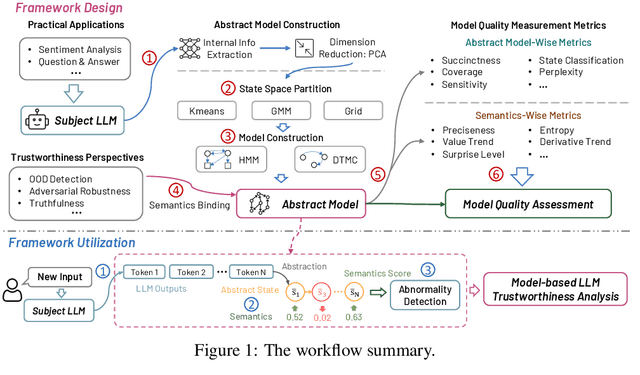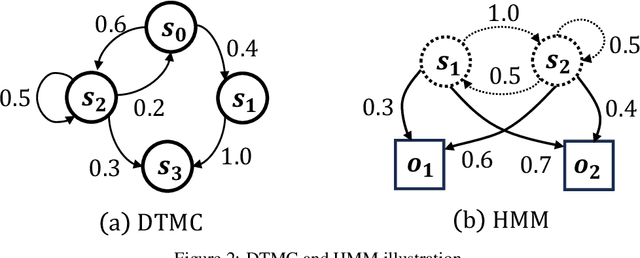Xuan Xie
Cross-Patient Pseudo Bags Generation and Curriculum Contrastive Learning for Imbalanced Multiclassification of Whole Slide Image
Nov 18, 2024Abstract:Pathology computing has dramatically improved pathologists' workflow and diagnostic decision-making processes. Although computer-aided diagnostic systems have shown considerable value in whole slide image (WSI) analysis, the problem of multi-classification under sample imbalance remains an intractable challenge. To address this, we propose learning fine-grained information by generating sub-bags with feature distributions similar to the original WSIs. Additionally, we utilize a pseudo-bag generation algorithm to further leverage the abundant and redundant information in WSIs, allowing efficient training in unbalanced-sample multi-classification tasks. Furthermore, we introduce an affinity-based sample selection and curriculum contrastive learning strategy to enhance the stability of model representation learning. Unlike previous approaches, our framework transitions from learning bag-level representations to understanding and exploiting the feature distribution of multi-instance bags. Our method demonstrates significant performance improvements on three datasets, including tumor classification and lymph node metastasis. On average, it achieves a 4.39-point improvement in F1 score compared to the second-best method across the three tasks, underscoring its superior performance.
LeCov: Multi-level Testing Criteria for Large Language Models
Aug 20, 2024



Abstract:Large Language Models (LLMs) are widely used in many different domains, but because of their limited interpretability, there are questions about how trustworthy they are in various perspectives, e.g., truthfulness and toxicity. Recent research has started developing testing methods for LLMs, aiming to uncover untrustworthy issues, i.e., defects, before deployment. However, systematic and formalized testing criteria are lacking, which hinders a comprehensive assessment of the extent and adequacy of testing exploration. To mitigate this threat, we propose a set of multi-level testing criteria, LeCov, for LLMs. The criteria consider three crucial LLM internal components, i.e., the attention mechanism, feed-forward neurons, and uncertainty, and contain nine types of testing criteria in total. We apply the criteria in two scenarios: test prioritization and coverage-guided testing. The experiment evaluation, on three models and four datasets, demonstrates the usefulness and effectiveness of LeCov.
MORTAR: A Model-based Runtime Action Repair Framework for AI-enabled Cyber-Physical Systems
Aug 07, 2024Abstract:Cyber-Physical Systems (CPSs) are increasingly prevalent across various industrial and daily-life domains, with applications ranging from robotic operations to autonomous driving. With recent advancements in artificial intelligence (AI), learning-based components, especially AI controllers, have become essential in enhancing the functionality and efficiency of CPSs. However, the lack of interpretability in these AI controllers presents challenges to the safety and quality assurance of AI-enabled CPSs (AI-CPSs). Existing methods for improving the safety of AI controllers often involve neural network repair, which requires retraining with additional adversarial examples or access to detailed internal information of the neural network. Hence, these approaches have limited applicability for black-box policies, where only the inputs and outputs are accessible during operation. To overcome this, we propose MORTAR, a runtime action repair framework designed for AI-CPSs in this work. MORTAR begins by constructing a prediction model that forecasts the quality of actions proposed by the AI controller. If an unsafe action is detected, MORTAR then initiates a repair process to correct it. The generation of repaired actions is achieved through an optimization process guided by the safety estimates from the prediction model. We evaluate the effectiveness of MORTAR across various CPS tasks and AI controllers. The results demonstrate that MORTAR can efficiently improve task completion rates of AI controllers under specified safety specifications. Meanwhile, it also maintains minimal computational overhead, ensuring real-time operation of the AI-CPSs.
GenSafe: A Generalizable Safety Enhancer for Safe Reinforcement Learning Algorithms Based on Reduced Order Markov Decision Process Model
Jun 06, 2024Abstract:Although deep reinforcement learning has demonstrated impressive achievements in controlling various autonomous systems, e.g., autonomous vehicles or humanoid robots, its inherent reliance on random exploration raises safety concerns in their real-world applications. To improve system safety during the learning process, a variety of Safe Reinforcement Learning (SRL) algorithms have been proposed, which usually incorporate safety constraints within the Constrained Markov Decision Process (CMDP) framework. However, the efficacy of these SRL algorithms often relies on accurate function approximations, a task that is notably challenging to accomplish in the early learning stages due to data insufficiency. To address this problem, we introduce a Genralizable Safety enhancer (GenSafe) in this work. Leveraging model order reduction techniques, we first construct a Reduced Order Markov Decision Process (ROMDP) as a low-dimensional proxy for the original cost function in CMDP. Then, by solving ROMDP-based constraints that are reformulated from the original cost constraints, the proposed GenSafe refines the actions taken by the agent to enhance the possibility of constraint satisfaction. Essentially, GenSafe acts as an additional safety layer for SRL algorithms, offering broad compatibility across diverse SRL approaches. The performance of GenSafe is examined on multiple SRL benchmark problems. The results show that, it is not only able to improve the safety performance, especially in the early learning phases, but also to maintain the task performance at a satisfactory level.
Online Safety Analysis for LLMs: a Benchmark, an Assessment, and a Path Forward
Apr 12, 2024Abstract:While Large Language Models (LLMs) have seen widespread applications across numerous fields, their limited interpretability poses concerns regarding their safe operations from multiple aspects, e.g., truthfulness, robustness, and fairness. Recent research has started developing quality assurance methods for LLMs, introducing techniques such as offline detector-based or uncertainty estimation methods. However, these approaches predominantly concentrate on post-generation analysis, leaving the online safety analysis for LLMs during the generation phase an unexplored area. To bridge this gap, we conduct in this work a comprehensive evaluation of the effectiveness of existing online safety analysis methods on LLMs. We begin with a pilot study that validates the feasibility of detecting unsafe outputs in the early generation process. Following this, we establish the first publicly available benchmark of online safety analysis for LLMs, including a broad spectrum of methods, models, tasks, datasets, and evaluation metrics. Utilizing this benchmark, we extensively analyze the performance of state-of-the-art online safety analysis methods on both open-source and closed-source LLMs. This analysis reveals the strengths and weaknesses of individual methods and offers valuable insights into selecting the most appropriate method based on specific application scenarios and task requirements. Furthermore, we also explore the potential of using hybridization methods, i.e., combining multiple methods to derive a collective safety conclusion, to enhance the efficacy of online safety analysis for LLMs. Our findings indicate a promising direction for the development of innovative and trustworthy quality assurance methodologies for LLMs, facilitating their reliable deployments across diverse domains.
LUNA: A Model-Based Universal Analysis Framework for Large Language Models
Oct 22, 2023



Abstract:Over the past decade, Artificial Intelligence (AI) has had great success recently and is being used in a wide range of academic and industrial fields. More recently, LLMs have made rapid advancements that have propelled AI to a new level, enabling even more diverse applications and industrial domains with intelligence, particularly in areas like software engineering and natural language processing. Nevertheless, a number of emerging trustworthiness concerns and issues exhibited in LLMs have already recently received much attention, without properly solving which the widespread adoption of LLMs could be greatly hindered in practice. The distinctive characteristics of LLMs, such as the self-attention mechanism, extremely large model scale, and autoregressive generation schema, differ from classic AI software based on CNNs and RNNs and present new challenges for quality analysis. Up to the present, it still lacks universal and systematic analysis techniques for LLMs despite the urgent industrial demand. Towards bridging this gap, we initiate an early exploratory study and propose a universal analysis framework for LLMs, LUNA, designed to be general and extensible, to enable versatile analysis of LLMs from multiple quality perspectives in a human-interpretable manner. In particular, we first leverage the data from desired trustworthiness perspectives to construct an abstract model as an auxiliary analysis asset, which is empowered by various abstract model construction methods. To assess the quality of the abstract model, we collect and define a number of evaluation metrics, aiming at both abstract model level and the semantics level. Then, the semantics, which is the degree of satisfaction of the LLM w.r.t. the trustworthiness perspective, is bound to and enriches the abstract model with semantics, which enables more detailed analysis applications for diverse purposes.
Towards Building AI-CPS with NVIDIA Isaac Sim: An Industrial Benchmark and Case Study for Robotics Manipulation
Jul 31, 2023Abstract:As a representative cyber-physical system (CPS), robotic manipulator has been widely adopted in various academic research and industrial processes, indicating its potential to act as a universal interface between the cyber and the physical worlds. Recent studies in robotics manipulation have started employing artificial intelligence (AI) approaches as controllers to achieve better adaptability and performance. However, the inherent challenge of explaining AI components introduces uncertainty and unreliability to these AI-enabled robotics systems, necessitating a reliable development platform for system design and performance assessment. As a foundational step towards building reliable AI-enabled robotics systems, we propose a public industrial benchmark for robotics manipulation in this paper. It leverages NVIDIA Omniverse Isaac Sim as the simulation platform, encompassing eight representative manipulation tasks and multiple AI software controllers. An extensive evaluation is conducted to analyze the performance of AI controllers in solving robotics manipulation tasks, enabling a thorough understanding of their effectiveness. To further demonstrate the applicability of our benchmark, we develop a falsification framework that is compatible with physical simulators and OpenAI Gym environments. This framework bridges the gap between traditional testing methods and modern physics engine-based simulations. The effectiveness of different optimization methods in falsifying AI-enabled robotics manipulation with physical simulators is examined via a falsification test. Our work not only establishes a foundation for the design and development of AI-enabled robotics systems but also provides practical experience and guidance to practitioners in this field, promoting further research in this critical academic and industrial domain.
Neuro-Symbolic Verification of Deep Neural Networks
Mar 02, 2022


Abstract:Formal verification has emerged as a powerful approach to ensure the safety and reliability of deep neural networks. However, current verification tools are limited to only a handful of properties that can be expressed as first-order constraints over the inputs and output of a network. While adversarial robustness and fairness fall under this category, many real-world properties (e.g., "an autonomous vehicle has to stop in front of a stop sign") remain outside the scope of existing verification technology. To mitigate this severe practical restriction, we introduce a novel framework for verifying neural networks, named neuro-symbolic verification. The key idea is to use neural networks as part of the otherwise logical specification, enabling the verification of a wide variety of complex, real-world properties, including the one above. Moreover, we demonstrate how neuro-symbolic verification can be implemented on top of existing verification infrastructure for neural networks, making our framework easily accessible to researchers and practitioners alike.
 Add to Chrome
Add to Chrome Add to Firefox
Add to Firefox Add to Edge
Add to Edge